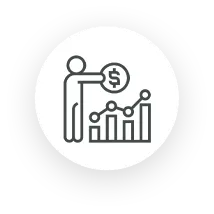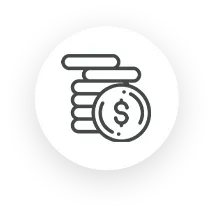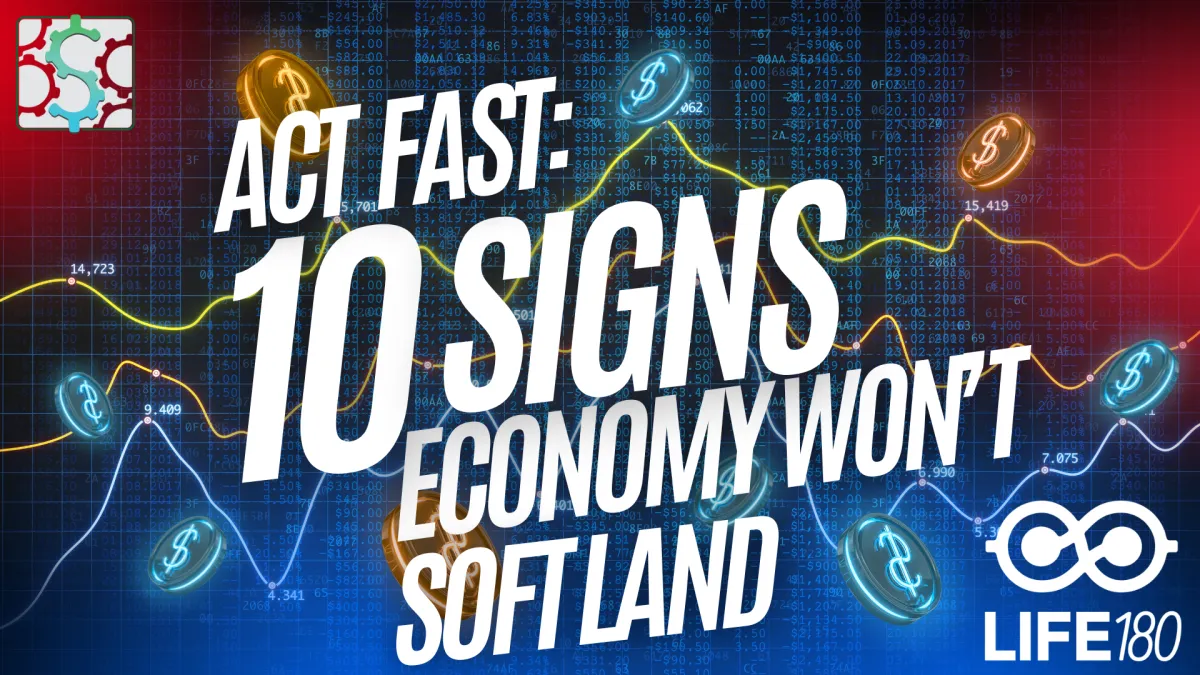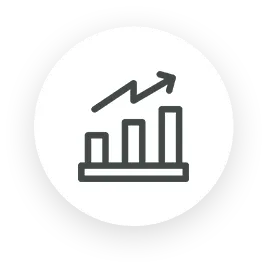
Simplifying Financial Confusion
LEARN CASH FLOW HACKING TO REACH FINANCIAL FREEDOM
Used by 90% of millionaires to reach their financial goals 4x faster

Achieve Financial Freedom Through Cash Flow Hacking

Increase Your Lifestyle While You Build Your Wealth

Position Yourself to Thrive in Market Downturn
YOU SHOULD NOT FEEL OUT OF CONTROL ABOUT YOUR FINANCIAL STRATEGY

Have easy access to your money in case of emergencies and opportunities

Use the investment strategy 90% of millionaires use

You deserve a clear plan to consistently grow your money and avoid market uncertainty

Have a guide and advisor that has your best interest in mind

Do not overpay in taxes

Stop guessing at the best vehicles to protect and grow your money

Act Fast: 10 Signs Economy Won't Soft Land
This article is a written adaptation of the content you can find on our YouTube channel, LIFE180.
Intro 10 signs we are not going to have a soft landing
Inflation remains elevated at the moment. While the Federal Reserve's target inflation rate is 2%, it is still higher than the historically low rates we've experienced over the past decade. Currently, short-term bonds offer higher returns compared to long-term bonds. Additionally, we have entered a recession. These are all macroeconomic factors that are largely beyond individual control.
Today, I want to discuss the 10 signs that lead me to believe we are not heading for a soft landing in the economy. Despite Jerome Powell, the chairman of the Federal Reserve, assuring the public that a soft landing is possible and that he can manage the situation, the evidence suggests otherwise.
Politicians, especially with the upcoming election season, want us to believe that a soft landing is inevitable and that we should feel confident. However, the issue is that I'm noticing certain trends in the economy.
While they may be able to sidestep or manage individual problems, when you combine these 10 factors, it becomes much harder to avoid the overall impact. That’s the real concern.
In this article, I'm going to walk you through the 10 signs I'm observing, discussing them in sequential order. I'll explain each one in the context of how it contributes to the growing risk that we won't achieve a soft landing for the economy.
In fact, each of these signs individually has the potential to drive us into worse economic conditions, such as a recession. When all of them occur simultaneously, the risk becomes even more pronounced. So, without further ado, let’s dive into these factors.
Sign 1 - Inflation Is Still 60-70% higher than target inflation levels
Sign number one is that inflation remains elevated. As of August 2024, core inflation is sitting between 3.2% and 3.4%. While this may seem moderate compared to the 9% we saw in 2022, it’s still significantly above the Federal Reserve's target inflation rate of 2%.
Even though the current rate is a fraction of what it was at its peak, it remains 60-70% higher than the Fed's desired level, which is still cause for concern.
Given the current environment, it's important to consider the Federal Reserve's recent actions. As of the time I’m recording this, just before the Federal Open Market Committee meeting, I anticipate that Jerome Powell will announce a rate cut for September. This speculation is based on the ongoing economic conditions and the Fed's approach to managing inflation and economic growth.
If the Federal Reserve is cutting rates before achieving the target inflation level, it indicates potential trouble ahead. The need to lower rates before inflation is brought under control suggests that the Fed is using rate cuts to inject stimulus into the economy. This move typically signals that the economy requires additional support, raising concerns about underlying economic issues that might be worsening.
When the Federal Reserve raises rates, their goal is to withdraw money from the economy to combat inflationary pressures. Conversely, reducing rates allows more money to flow into the economy, aiming to stimulate economic activity. This adjustment is a crucial tool for managing economic conditions and addressing various challenges.
This counterintuitive approach to monetary policy, raising rates to curb inflation while simultaneously cutting rates to stimulate the economy, reveals that the economic situation may not be as robust as officials would like us to believe. It suggests underlying challenges and weaknesses in the economy that are not immediately apparent from surface-level indicators.
Sign 2 - Interest Rates Remain Elevated
Sign number two highlights a different aspect of the economic landscape: elevated interest rates. Even if Jerome Powell starts to cut the federal funds rate and taper it slightly, the rates for mortgages, car loans, credit cards, personal loans, and business loans will remain high compared to the historically low rates we’ve experienced over the past decade. This means that, despite potential reductions, borrowing costs will still be elevated relative to long-term trends.
Given that asset prices have inflated due to the previously low-interest-rate environment, the current high-interest rates pose a significant challenge. Even if rates are cut to inject more money into the economy, this could reignite inflationary pressures. Essentially, lowering rates again might simply exacerbate existing inflation issues rather than providing the intended economic stimulus.
With elevated interest rates, we could face a situation where inflation rates rise again. This would be compounded by the fact that we're starting from a higher baseline for interest rates. Consequently, the cost of goods and services would remain more expensive compared to pre-pandemic levels, adding further financial pressure.
Sign 3 - The Inverted Yield Curve
The third sign is the inverted yield curve, which is a significant indicator to watch. In simple terms, an inverted yield curve occurs when short-term bonds offer higher returns than long-term bonds. This inversion often signals investor concerns about future economic conditions, as it suggests that investors are seeking safer, shorter-term investments due to uncertainty about long-term economic stability.
Traditionally, long-term bonds are expected to offer higher returns than short-term bonds to compensate for the increased uncertainty and risk associated with locking in your money for a longer period.
An inverted yield curve, where short-term bonds yield more than long-term ones, contradicts this conventional financial principle and often signals concerns about future economic conditions or potential recessions.
In a typical financial scenario, short-term bonds are considered safer and more predictable, leading to lower returns compared to long-term bonds, which carry more risk and uncertainty. However, when the yield curve inverts, meaning short-term bonds offer higher returns than long-term ones, it historically indicates an impending recession.
This inversion has proven to be 100% accurate in predicting recessions in the past. Currently, while the yield curve is inverted, we haven't yet entered a technical recession, which adds to the uncertainty and concern about future economic conditions.
Despite assurances from politicians and economists suggesting that we haven't yet entered a recession, the persistent inverted yield curve and other economic indicators point to a potential downturn. It's increasingly likely that a recession is imminent, even if it hasn't been officially declared yet.
Sign 4 - Decline in Consumer Confidence
This brings us to sign number four: declining consumer confidence. From my conversations with individuals daily, whether I'm coaching them on personal finances, debt management, credit rebuilding, or positioning for future opportunities, it's evident that consumer confidence is waning. This decline reflects broader concerns about economic stability and future prospects.
People are experiencing a significant crisis of confidence regarding the future. There’s a palpable fear and growing uncertainty about the direction of the country, which erodes consumer confidence.
This uncertainty doesn't just stem from traditional economic metrics like inflation or CPI; it deeply affects how people feel about the economy’s stability and their own financial futures. Consumer confidence, or the lack thereof, becomes a crucial indicator of economic health, often revealing more about the general sentiment than raw data alone.
Consumer confidence plays a critical role in economic health. When people are confident, they are more likely to spend money, sometimes beyond their means, which fuels economic activity.
Conversely, a lack of confidence leads individuals to tighten their belts, reducing spending and, consequently, slowing down the economy. This shift in behavior has a profound impact on economic growth and stability.
When an over-leveraged system experiences a tightening of consumer spending, the effects are felt throughout the economy. Reduced spending impacts businesses, leading to lower revenues and potentially causing financial strain. This can trigger a ripple effect, where companies face difficulties and start failing, which in turn leads to increased defaults, bankruptcies, and foreclosures.
The cascading consequences of decreased consumer confidence and spending can significantly destabilize the economic landscape. I'll delve deeper into this as we continue through the signs.
Sign 5 - Geopolitical Tensions & Uncertainty
Sign number five is the geopolitical uncertainty we're currently facing. Geopolitical tensions, ongoing conflicts, trade wars, and global pandemics all contribute to a climate of instability and unpredictability in the markets.
These factors can disrupt global supply chains, create economic volatility, and impact investor confidence. The resulting uncertainty can exacerbate existing economic challenges and make it even harder to achieve a smooth economic transition or "soft landing."
This ties back to the earlier point about uncertainty. The accumulation of these factors, geopolitical tensions, economic instability, and the lack of consumer confidence, illustrates a broader problem.
We’ve been navigating these issues and avoiding the financial consequences for some time, but there’s a limit to how long we can continue to print money and delay the inevitable financial repercussions. Eventually, the weight of these challenges will catch up with us, making it increasingly difficult to avoid the associated economic pain.
So, the first five signs I’ve discussed highlight macroeconomic factors that are largely beyond our control. I understand that it can be frustrating to deal with these high-level issues, especially when they seem so daunting.
It’s really disheartening when you feel like so many factors affecting your life are beyond your control. That sense of helplessness can make it challenging to take action and make the right decisions to influence your own outcomes.
Absolutely, a confused mind often defaults to inaction. When you feel overwhelmed by things you can't control and don’t know how to address them, it’s easy to just stick with the familiar, even if it’s not the best option. Understanding and clarity are crucial for making informed decisions and taking proactive steps.
Sign 6 - Consumer Debt Is At All Time Highs
In this section we will focus on the specific consumer issues that are impacting individuals and offer practical steps you can take to address these challenges. By understanding these factors and implementing actionable strategies, you can better navigate the economic landscape and work towards achieving your financial goals.
Consumer debt levels in the U.S. have reached unprecedented levels, with total household debt hitting a staggering $17.8 trillion. While there's significant concern about the government's $34 trillion debt and associated unfunded liabilities, it's striking to note that consumer debt now constitutes 50% of the federal debt.
That is a substantial and alarming figure that reflects the mounting financial pressures on American households. This surge in consumer debt encompasses a significant rise in credit card debt and auto loan debt, among other categories. I'll delve into the reasons behind this increase shortly.
Sign 7 - Auto Repossessions Are 23% Higher Year over Year
Sign number seven highlights a troubling trend: auto repossessions have surged by 23% from 2023 to 2024. This sharp increase reflects broader financial distress among consumers and signals growing difficulties in meeting auto loan obligations.
Sign number seven highlights a troubling trend: auto repossessions have surged by 23% from 2023 to 2024. This significant increase reflects growing financial strain among consumers and points to wider issues with meeting auto loan obligations.
To understand why this is happening, consider the broader economic context. The rise in auto repossessions is largely driven by a severe cash flow crunch among consumers. One major factor contributing to this situation is the widening wage gap, which has significantly impacted many households' ability to manage their financial commitments.
The rising cost of living, driven by inflation, has far outpaced wage growth, creating a widening gap between what people earn and what they need to spend. This disparity is becoming more pronounced as the cost of essential goods, including cars, continues to increase.
While wages have risen slightly over time, they haven't kept up with the surging prices, leaving many consumers struggling to manage their expenses, particularly for big-ticket items like vehicles.
In 2020, the average cost of a new car was $36,000, with an average interest rate of 5%. This resulted in an average monthly auto payment of $679. Fast forward to 2024, and the numbers have significantly changed. The price of a new car has increased by 48%, translating to a $12,000 rise in cost. This alone represents a 33% increase in the overall expense of purchasing a vehicle.
But it’s even worse than it appears. While there’s a 33% increase in the cost of vehicles from 2020 to 2024, the real issue lies in the interest rates. The average interest rate has jumped from 5% to 9%, and the average monthly car payment has surged to $996. From a cash flow perspective, this represents a staggering 46.7% increase in what people are paying monthly for their cars, creating significant pressure on household budgets.
This additional $300 to $400 per month, representing a 47% increase in payments, often becomes the tipping point between financial success and failure for many individuals. Month to month, people are finding themselves overstretched, struggling to keep up with these rising expenses.
Sign 8 - Unemployment Is Trending Up
This leads us to sign number eight: rising unemployment. Unemployment is trending upward, and people who have taken on significant debt are now facing situations where they might lose their jobs, or their incomes are shrinking, causing greater uncertainty. These factors are far from positive. This growing financial strain is contributing to the increase in car repossessions, further exacerbating the issue.
As I mentioned earlier, rising inflation is widening the gap between wage growth and the cost of living. This growing disparity is at the heart of many issues we're seeing across various sectors. It's not just a single problem, it’s creating ripple effects that are causing financial challenges in numerous other areas.
Sign 9 - Housing Pressures
Now, let's address the issue directly. With unemployment on the rise, sign number nine points to the growing inflation rate, the wage growth disparity, and the mounting pressures in the housing market. What we're seeing with auto repossessions is also happening in the housing sector, where the same financial strains are becoming evident.
Let's take a closer look at the housing market. In 2020, the median home price was around $320,000, with an average mortgage rate of 3%. This meant your monthly principal and interest payments came to approximately $1,349. Fast forward to 2024, and the median home price has risen by $120,000, bringing it to an average of $440,000, a significant 35-40% increase.
However, the real issue lies in the cost of borrowing. With inflation rising and interest rates remaining high, the average mortgage rate now sits at 7%, adding substantial pressure to homebuyers.
Now, the average monthly principal and interest (P&I) payments on a median-priced home in the U.S. have skyrocketed to $2,927. To put this into perspective, I bought a house in 2020, and that same house is now valued at over a million dollars. This $2,927 figure is roughly equivalent to my current mortgage payment, including taxes and insurance.
Right now, the cost of housing has surged to the point where, for a $440,000 home, you can’t even match the affordability of what my million-dollar home costs me. It’s unbelievable, a 110% increase. Think about that. From 2020 to 2024, the purchasing power needed has risen by 110%, which is staggering.
So, what can people really do in this situation? Honestly, my advice, especially when it comes to decisions around your home, is not something I’d give lightly. It's important to take a step back and assess your own circumstances. You need to carefully evaluate where you think the market and economy are headed before making any decisions.
Here Is What To Do To Create Opportunity In Uncertain Times
One thing I always emphasize is the importance of aligning your money with your values and beliefs. That’s a principle I live by. So when people ask, “Chris, what would you do?” my response is always the same: I can’t tell you what to do if I were in your shoes. I can only share what I’m doing based on my own beliefs, skills, and values.
When I look at the entire situation, the reasons are clear. To recap: inflation remains elevated, and interest rates, even when they drop, will still be higher than they've been over the past decade.
The inverted yield curve, which has a 100% prediction rate for signaling a recession, is another key indicator. Declining consumer confidence is another concern, and the ongoing geopolitical uncertainty adds more complexity to an already unstable landscape.
These five macro-level reasons point toward or signal we're heading into a recession. Now, let's move to reason number six: consumer debt levels are at an all-time high. This is a significant indicator of economic strain.
Then, there's reason number seven: the surge in auto repossessions. This has historically been a strong indicator that tough times are ahead. I've already explained the reasons behind this and how the rising cost of money has a direct impact.
Unemployment is on the rise, and housing market pressures are undeniable. Recently, I was watching ReVenture Capital, and they discussed states like Florida and Texas, where the narrative around housing supply has shifted. For a long time, the belief was that housing would remain stable because of low supply. But now, that’s starting to change.
It took time to build all these houses, and initially, supply was low. However, builders reacted by constructing more homes without fully considering the long-term consequences of rising interest rates.
Now, in areas that were previously overinflated, like Florida and Texas, there's an excess of inventory. This surplus raises concerns about its impact on the housing market. Combined with elevated interest rates, this situation creates a precarious scenario for the housing sector and the broader economy.
Considering that inflation has remained high while wages have not kept pace with rising costs, the current discussions about cutting interest rates or the federal funds rate to stimulate the economy reflect growing concern over rising unemployment. This approach aims to counteract economic slowdowns but also underscores the challenges we face.
I recently read that GMC has just cut a thousand jobs in its software engineering division, specifically targeting positions related to computer programming and software development. This significant reduction in workforce underscores the broader trend of companies streamlining operations in response to current economic pressures.
Given these indicators, what actions can you take? Focus on reducing your debt and restructuring your finances to better align with the current economic landscape. While I won't advise you on specific investment strategies or asset reallocations, it's crucial to assess your financial situation and make adjustments as necessary to safeguard your financial well-being.
What I would emphasize is the importance of maintaining liquidity. In the event that these indicators lead to a recessionary environment, having readily accessible capital will position you to capitalize on the opportunities that arise during such times. Keeping some “dry powder” on hand can provide you with the flexibility to navigate and benefit from the evolving economic conditions.
Take Advantage Of The Market Cycles
One of the key points I frequently discuss is the cyclical nature of the market. The market moves in cycles, meaning that it goes through periods of upward and downward trends. When we examine the market, it's essential to understand that, historically, it trends upward over time. This upward trend is a positive aspect of the market's long-term behavior.
That's why many long-term investors advocate a buy-and-hold strategy. They argue that while there may be losses during market downturns, the key is to buy when prices are low and sell when they are high. By riding out the market's fluctuations, you can potentially benefit from the overall upward trend and minimize the risk of loss over time.
If you don't need to access your money immediately, then holding onto investments through market fluctuations can be fine. However, the drawback of this approach is the opportunity cost.
By not taking advantage of downturns, like those in 2008 or briefly in 2020, or during the dot-com bubble of 2000-2001, you may miss out on significant opportunities for gains. It's important to consider how to strategically position yourself to capitalize on these market cycles.
You can see a predictable pattern where every 8 to 12 years, market environments shift dramatically. With this in mind, prepare yourself for these fluctuations. While it's wise to have some money invested for the long term, it's equally important to maintain what I call an “opportunity fund.” This fund allows you to take advantage of market downturns and emerging opportunities, positioning yourself for potential gains when others may be more hesitant.
Ensure you have sufficient liquid, accessible capital readily available. Focus on eliminating toxic debt to free up cash flow. This might involve side hustles to boost your income and enhance your credit. The goal is to be well-prepared, with financial flexibility to seize opportunities when they arise.
Right now is the time to focus on building your credit. By having your financial foundation set up properly, you’ll be prepared for the next economic environment, whether or not we enter a recession. Being well-prepared ensures you can navigate any financial challenges and capitalize on opportunities that arise.
Even if a recession doesn’t materialize, we’ll likely face a period of slower growth. During such times, it's crucial to be strategic in selecting your investments. Given the current overvaluation of markets, I believe it's almost inevitable that we'll encounter some challenging economic conditions. That's my perspective based on the current financial landscape.
I don’t know if this resonates with you or not, but I felt compelled to write this article due to some comments on my videos suggesting that talking about an impending recession is fear-mongering. That’s not my intention at all.
My goal is to encourage preparation by evaluating both the potential upside and downside, and assessing whether you can handle the downside. The points I’ve discussed are based on facts, not opinions. They reflect current economic conditions, supported by data, polls, and studies about the economy and public sentiment.
Let’s face it: the psychology of the population drives the economy. There’s no getting around it. Demographics and public sentiment play a crucial role in economic trends. When you combine this with metrics like interest rates, cost of goods, CPI, spending habits, and trends in repossession and foreclosure rates, you get a clearer picture of the economy's health. If people are feeling concerned and uncertain, it’s challenging to imagine navigating these issues without experiencing some degree of economic pain.
I also believe that sometimes, as human beings, we need to experience some level of hardship to realign our perspectives. We tend to take economic upswings for granted and often have short memories about past downturns, like the one in 2008. Many people who are now in their 30s may not even recall 2008 because they were too young to fully experience it.
Every generation faces its own set of challenges, and it's human nature to encounter periods of difficulty. For those who think we might avoid such challenges now, I’d argue: in what world has any generation escaped facing tough times? It’s an inherent part of our economic cycle.
I hope this helps clarify the situation and starts to piece together the puzzle for you. Regardless of whether the economy continues to grow or faces a downturn, it's important to prepare yourself to be in a better position. My goal is for you to be ready and resilient, no matter what happens.
If you have any questions, feel free to check out the links below. If you're looking to eliminate debt, rebuild your credit, and optimize your financial situation, we offer a comprehensive program designed to streamline and accelerate that process. Right now, taking these steps might be one of the most strategic moves you can make.
If you're interested in setting up a clarity call to learn how to build your best opportunity fund, implement cash flow investing, and explore what I call cash flow hacking, go down below and schedule a call. Our team will be happy to assist you.
So, that’s it for now. I hope this hasn’t overwhelmed or scared you too much. Until next time, have a blessed and inspirational day.
HOW TO START TAKING CONTROL OF YOUR FINANCES BY MAXIMIZING YOUR CASH FLOW AND PROTECTING YOUR ASSETS

1. Schedule Your Free Clarity Call

2. Create a Free Customized Plan

3. Get Guide to Financial Success
GET YOUR FREE COPY TO STOP USING OUTDATED RETIREMENT STRATEGIES
Cash Flow Hacking teaches you to:
Protect Your Investments
Thrive in bad markets
Reach financial freedom faster

ARE YOU LOOKING FOR:

Cash Flow Hacking teaches you to:
Security to protect your money
Increased cash flow and lifestyle
Inflation protection
Financial certainty in all economic environments
A reduction in taxes
Safe and fast access to your money with no penalties
WHO IS THIS PROGRAM FOR?

People looking for an alternative
Are you looking for alternatives to Wall Street’s “buy and hold” strategy that takes 40 years with uncertain results? Our Cash Flow Hacking strategies provide you the building blocks to get started on the right foot

Passionate Entrepreneurs
Are you looking for a financial strategy that will take your best assets (you and your businesses) and multiply their potential? Our Cash Flow hacking strategies will teach you how to invest for the future without sacrificing building your business

Real Estate
Investors
Are you a real estate investor who is burned out from being a landlord or playing the fix-and-flip game? Our Cash Flow Hacking strategies will provide you with the system to create predictable wealth AND give you the freedom you are looking for.
YOU DESERVE PEACE OF MIND AND A PLAN THAT WILL PROTECT YOUR FAMILY AND GROW YOUR WEALTH
Today you need to be more savvy than ever if you try to go at it alone.
Losing money to inflation, taxes, and just poor investment strategies is leaving you frustrated, feeling out of control and not knowing where to turn. To add to the problem, the market is flooded with advisors who have outdated advice that does not place your best interests first, but instead focuses on charging you a fee that creates guaranteed cash flow for them.
NOT YOU
We believe this is wrong and that your security and best interests should be placed first. We believe you should be in a position where you control your money, your money doesn't control you. We understand because we talk with hardworking people everyday that are losing money in the markets based on old information and feel like they are guessing at the best course of action.
We created the Cash Flow Hacking plan to help you have security and control of your money to take advantage of life's opportunities because you deserve peace of mind with your wealth. The old way of planning for retirement of… Go to school Get a job & save as much as you can in your 401k and mutual funds...is broken.
You have been lied to. Think about it, where else in life does someone tell you that the most certain way to achieve your desired result is to take on more risk? The math just doesn't work, and the results are showing in our country and world. Did you know that 90% of millionaires in the United States have 1 asset in common?
Hint: it's not stocks or mutual funds (and no...it's not crypto) How much sense does it make for you to work hard, save money, reduce your current lifestyle (because that's what you are doing when you save for the future - taking money you could use on lifestyle today and delaying gratification to a future unknown time), and hope that whatever you are doing will work three to four decades from now? If you're thinking, "not much sense at all…", you are in the right place.
With over 50 years of experience on our team, we have worked with thousands of individuals and families to achieve financial freedom faster and with more predictability by helping them invest for Cash Flow.
How does the Cash Flow Hacking Plan work? 1. Take the Cash Flow Hacking Challenge 2. Complete the LIFE180 X-Ray and determine what your Freedom Number is 3. Work with a Cash Flow Hacking expert to provide you a customized plan
The customized Cash Flow Hacking plan will give you clarity on where you are now, where you want to go (and in what time frame), and what you need to do to get there predictably.
We value and commit to you: We believe you deserve the best financial education and guidance We believe financial decisions should not be rushed but be well thought out with a plan We believe you should be in control of your money We believe we earn your trust through time, education, and proper due diligence Without a proper plan and guidance, your money can be lost to taxes, inflation, and bad investments You deserve more with the most up-to-date strategies to mitigate your risk, control your money, and earn stable returns regardless of the market Schedule a call here to attain your LIFE180 Financial X-Ray now or get started with the Cash Flow Hacking Challenge for free.
I am interested in...